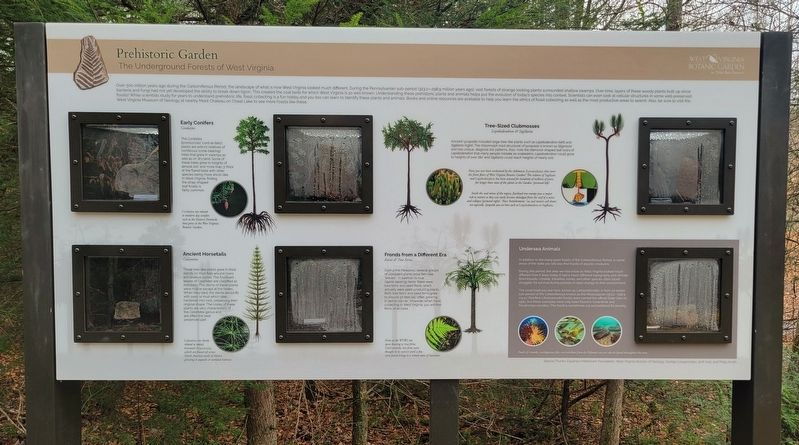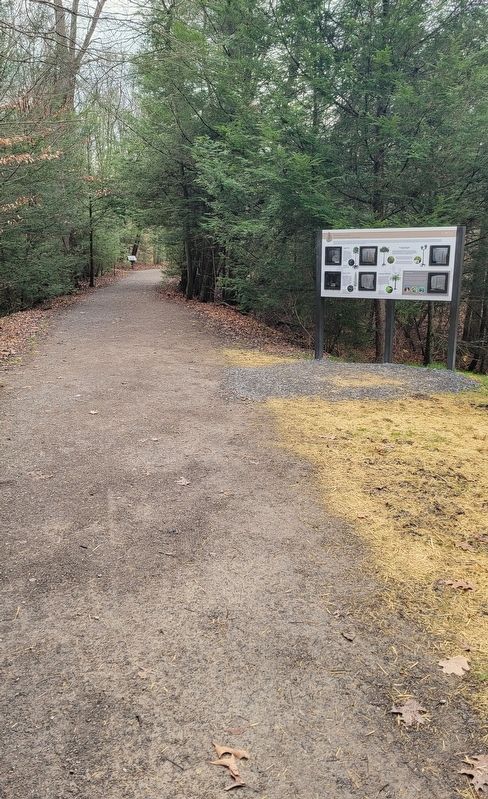Near Morgantown in Monongalia County, West Virginia — The American South (Appalachia)
Prehistoric Garden
The Underground Forests of West Virginia
Over 300 milion years ago during the Carboniferous Period, the landscape of what is now West Virginia looked much different. During the Pennsylvanian sub-period (323.2-298.9) million years ago), vast forests of strange looking plants surrounded shallow swamps. Over time, layers of these woody plants built up since bacteria and fungi had not yet developed the ability to break down lignin. This created the coal beds for which West Virginia is so well known. Understanding these prehistoric plants and animals helps put the evolution of today's species into context. Scientists can even look at cellular structures in some well-preserved fossils! While scientists study for years to understand prehistoric life, fossil collecting is a fun hobby and you too can learn to identify these plants and animals. Books and online resources are available to help you learn the ethics of fossil collecting as well as the most productive areas to search. Also be sure to visit the West Virginia Museum of Geology at nearby Mont Chateau on Cheat Lake to see more fossils like these.
Early Conifers
Cordaites
The Cordaites (pronounced 'cord-ai-teez') plants are extinct relatives of coniferous (cone-bearing) trees that grew in swamps as well as on dry land. Some of these trees grew to heights of almost 100' and more than 3' thick at the flared base with other species being more shrub-like. In West Virginia, finding the strap-shaped leaf fossils is fairly common.
Cordaites are related to modern day conifers such as the Eastern Hemlocks that grow at the West Virginia Botanic Garden.
Tree-Sized Clubmosses
Lepidodendron & Sigillaria
Ancient lycopsids included large tree-like plants such as Lepidodendron (left) and Sigillaria (right). The rhizomorph (root structure) of lycopsids is known as Stigmaria and has unique, diagonal dot patterns. Also, note the diamond-shaped leaf scars of Lepidodendron that many people mistake as snakeskins. Lepidodendron could grow to heights of over 180' and Sigillaria could reach heights of nearly 100'.
Have you ever been enchanted by the clubmosses (Lycopodium) that cover the forest floors of West Virginia Botanic Garden? This relative of Sigillaria and Lepidodendron has been around for hundreds of millions of years, far longer than most of the plants at the Garden. (pictured left)
Inside the coal mines of the region, fossilized tree stumps pose a major risk to miners as they can easily become dislodged from the roof of a mine and collapse (pictured right). These 'kettlebottoms' (as coal miners call them) are typically lycopsids you see here such as Lepidodendron or Sigillaria.
Ancient Horsetails
Calamites
These tree-like plants grew in thick stands on mud flats around rivers and shallow ponds. The fossilized leaves of Calamites are classified as Annularia. The stems of these plants were hollow except at the nodes. When they died, the stems would fill with sand or mud which later hardened into rock, preserving their original shape. The nodes of these plants are very characteristic of the Calamites genus and are often the best preserved part.
Calamites are closely related to today's horsetails (Equisitum), which are found all across North America north of Mexico growing in aquatic or wetland habitats.
Fronds from a Different Era
Ferns & Tree Ferns
During the Paleozoic, several groups of unrelated plants bore fern-like "leaves". In addition to true (spore-bearing) ferns, there were tree ferns and seed ferns, which actually were seed-producing plants. Both tree ferns and seed ferns grew to around 30 feet tall, often growing in dense stands. However, when fossil collecting in West Virginia, you will find ferns of all sizes.
Ferns at the WVBG are spore-bearing or true ferns. Until recently, tree ferns were thought to be extinct until a few were found living in a remote area of Australia.
Undersea Animals
In addition to the many plant fossils of the Carboniferous Period, in some areas of the state you will also find fossils of aquatic creatures.
During this period, the area we now know as West Virginia looked much different than it does today. It had a much different topography and climate. Brachiopods, crinoids, trilobites, corals, and other species often faced struggles for survival during periods of rapid change to their environment.
The coral fossil you see here, known as Lithostrotionella, is from an earlier sub-period of the Carboniferous known as the Mississippian (323.2-258.9 m.y.a.). Petrified Lithstrotionella fossils were named the official State Gem in 1990, but these examples have only been found in Greenbrier and Pocahontas counties. This fossil is sometimes cut and polished for jewelry.
(Caption):
Fossils of crinoids, cartilagenous fish, and trilobites from the Paleozoic era can also be found throughout the state.
Special Thanks: Equitrans Midstream Foundation, West Virginia Division of Geology, George Longenecker, Josh Hull, and Philip Smith
Erected 2023 by West Virginia Botanic Garden at Tibbs Run Preserve.
Topics. This historical marker is listed in these topic lists: Horticulture & Forestry • Paleontology. A significant historical year for this entry is 1990.
Location. 39° 37.676′ N, 79° 51.931′ W. Marker is near Morgantown, West Virginia, in Monongalia County. Marker can be reached from Tyrone Road (County Route 75) 0.1 miles south of Quartz Drive, on the right when traveling east. The marker is located on the Reservoir Loop Trail at the West Virginia Botanic Garden. Touch for map. Marker is at or near this postal address: 1061 Tyrone Road, Morgantown WV 26508, United States of America. Touch for directions.
Other nearby markers. At least 8 other markers are within walking distance of this marker. A Small Dam and a Big "Bowl" Meet the Need for Clean Water (within shouting distance of this marker); Strong Men and Horses Build the Basin (within shouting distance of this marker); Who Wants Clean Water? (about 500 feet away, measured in a direct line); Clean Water Comes To Morgantown (about 500 feet away); Remnants of the Past: The Dam and Outlet Tower (about 700 feet away); The Tibbs Run Reservoir: Then a Water Source, Now a Local Treasure (approx. 0.2 miles away); "Clean Mountain Water" Not So Clean (approx. ¼ mile away); Ralph Lemley: Resourceful Caretaker (approx. 0.3 miles away). Touch for a list and map of all markers in Morgantown.
Credits. This page was last revised on January 2, 2024. It was originally submitted on December 27, 2023, by Bradley Owen of Morgantown, West Virginia. This page has been viewed 85 times since then and 84 times this year. Photos: 1, 2. submitted on January 2, 2024, by Bradley Owen of Morgantown, West Virginia.

